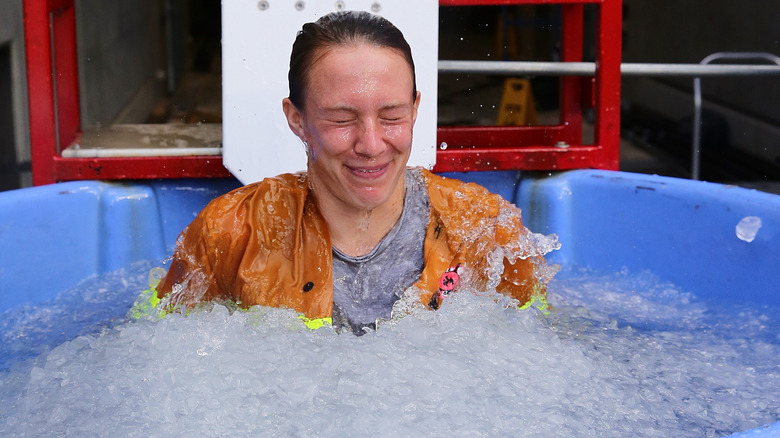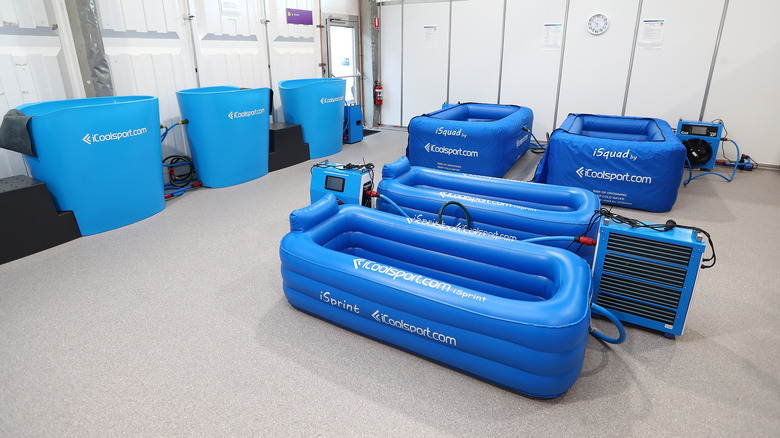What Really Happens To Your Body When You Take An Ice Bath Every Day
Does the idea of jumping into a tub of freezing-cold ice water sound appealing to you? Even though it might not sound like a first-choice activity for a relaxing evening, taking regular ice baths can have lots of benefits. And these ice cold (literally!) baths aren't just for elite athletes or that one friend who seems to run a marathon every weekend. Ice baths — which are also referred to as cryotherapy, cold exposure therapy, or cold water immersion (CWI), may benefit the average person by reducing muscle soreness, pain, and inflammation, even helping you sleep better (per Healthline).
Ice baths fall under the umbrella of thermal medicine and therapeutic baths, both of which can be traced back centuries to the Ancient Greeks, according to Well+Good. There's a reason the practice has stuck around for so long and why it's still often recommended today for people who experience chronic pain, muscle soreness, and trouble sleeping. Andri Einarrson, a cold water therapy leader, tells Well+Good that "There are many mental and physical benefits of cold exposure. For example, cold reduces inflammation, swelling, and sore muscles. It is also linked to improved quality of sleep, more focus, and even to an improved immune response. Participants have reported health benefits that range from higher energy levels to relief of symptoms caused by autoimmune diseases." All of these benefits are the reason that ice baths have won so many converts. If this sounds enticing, here's what you need to know about this chilly practice.
Benefits of ice baths
When you take an ice bath every day, or even a few times a week, you'll likely experience many of the benefits the practice can provide. To get the most out of an ice bath, timing is important — and according to Byrdie, dipping into a chilly tub right after you finish working out is the best time for your muscle health. How exactly does the magic happen? When you hop into an ice bath, your blood vessels constrict due to the drop in temperature, then rapidly dilate after you get out of the tub, which can aid in flushing out metabolic waste. Remember, safety should always come first and you should never stay in an ice bath for more than 15 minutes, otherwise you risk negative side effects like frostbite and hypothermia.
The drop in temperature your body experiences when you settle into an ice bath can also decrease inflammation by limiting the inflammatory response, helping you both feel better (especially if you suffer from chronic pain) and heal faster after a workout, reports Healthline. Your central nervous system also benefits from the ice bath, which can decrease fatigue, make you feel more energized, and help you sleep better at night. For the cherry on top, the effects of ice baths on the central nervous system can improve your reaction time and provide increased power during upcoming workouts.
How to get started with ice baths
To achieve the benefits of ice baths, it's important to adhere to proper and safe technique. Byrdie recommends that the water should be somewhere between 50 and 60 degrees Fahrenheit. If you're just starting out, you can try an initial ice bath at 68 degrees Fahrenheit and then work your way to a lower temperature (per Cleveland Clinic). To create an ice bath at home, fill the tub with cold water to approximately the halfway mark and then mix in three large commercial ice bags. After the ice water is ready, Healthline suggests you sit in the tub for 10-15 minutes. If you're just getting started, you can begin with five minutes and increase the time you spend in the tub as you become accustomed to the ice bath (per Cleveland Clinic).
There are some health conditions that don't mesh well with ice baths, so it's always best to check with your doctor before you begin a regular practice of taking the plunge. Don't try an ice bath if you have diabetes, poor circulation, peripheral neuropathy, venous stasis, cold agglutinin disease, high blood pressure, or cardiovascular disease (via Cleveland Clinic). If you're currently injured, including having a bone fracture, torn tendon or ligament, or any other acute issue, avoid ice baths until you have healed.



